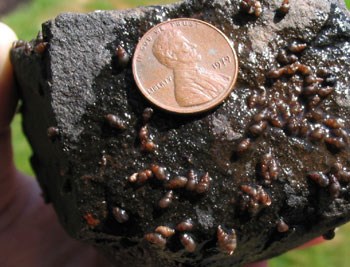
What Is a New Zealand Mud Snail?The New Zealand mud snail, Potamopyrgus antipodarum, is a very small species of freshwater snail endemic to New Zealand. It is an invasive species in many countries, including the United States, where populations of this snail can reach phenomenal densities. The snails were discovered in the Snake River, Idaho in 1987 and have since spread rapidly throughout the western United States to become established in rivers in 10 western states and three national parks, including Grand Canyon and Yellowstone. 
Why Is Staff Concerned About This Snail?While New Zealand mud snails have not yet been documented in Yosemite National Park, they have been recorded south of Mono Lake in waterways adjacent to the park’s eastern border. The snails have been found in the following California waters since their discovery in the Owens River in Mono County in 2000: Hot Creek (Mono), Bishop Creek Canal (Inyo), Lone Pine Creek (Inyo), Media Creek (Los Angeles), Lindero Creek (Los Angeles), Malibu Creek (Los Angeles), Solstice Creek (Los Angeles), Sugunda Descheca Creek (Orange), Trabuco Creek (Orange), Piru Creek (Ventura), Putah Creek (Yolo), Lower Calaveras River (Calaveras/San Joaquin), Mormon Slough (San Joaquin), Lower Mokelumne River (San Joaquin/Sacramento), American River (Sacramento), Rush Creek (Marin), Lower Napa River (Napa), San Lorenzo River (Santa Cruz), West Antioch Creek (Contra Costa) and Alameda Creek (Alameda). Park managers are concerned that this invasive species could inadvertantly be introduced to the park’s rivers, altering the natural ecosystems. Mud snail populations often reach densities greater than 28,000 individuals per square foot of suitable habitat, completely covering a streambed. They can comprise up to 95 percent of the invertebrate biomass of a river. The snails form colonies that disrupt the base of the food chain by consuming algae. This prolific snail crowds out native aquatic insects that provide food for many aquatic and terrestrial animals throughout the park, such as native fish species at low elevations, birds foraging from waterways, and endangered species like the Sierra Nevada yellow-legged frog. It is believed that the population in New Zealand is kept in check by a native parasite, but in North America it has no natural predators and may not easily be eradicated once established. 
The New Zealand mud snail can survive several days outside of water, can withstand a wide range of temperatures, and are small enough to be inadvertantly spread by many types of water users. All waters are vulnerable, from silted river bottoms to clear mountain streams. Since the snails reproduce asexually, it only takes ones attached to fishing gear, watercraft, pets, clothing or anything else that comes into contact with water to spread them. What Can I Do to Help Prevent the Spread of New Zealand Mud Snails?Help the National Park Service by being aware and avoiding transport of these unwanted visitors. Invasive species are having a huge impact on our resources nationwide. It is much easier to prevent the spread of invasive species than to try to eradicate them once they are introduced.
|
Last updated: June 1, 2023
